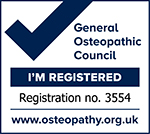Treatment doesn’t generally hurt although you may experience short periods of discomfort. Many people quite enjoy the treatment and also the feeling of released tension. Some people experience feeling ‘lighter’ or ‘taller’ after a treatment.
It is not uncommon, for patients presenting with acute pain, that they can feel sore for up to 48hrs after the treatment. This is because joints, ligaments and muscles that are already inflamed may need to be manipulated to be ‘corrected’. This soreness is usually far more desirable than the acute pain that the patient was previously in!!
With manipulation to a joint, including those of the spine, there is often an accompanying ‘click’. This is actually due to a bubble of gas appearing within the joint for a fraction of a second as the joint is gapped. The effect of stretching the joint is to influence the nerve endings in it to reset the reflexes with surrounding muscles and therefore normalizing muscle tension.
Your treatment plan will depend on different factors. After the first consultation the osteopath will have made an assessment and will be able to give you an idea of this. Usually, the longer you have had a problem the longer it will take to get rid of. It may only take one or two treatments to help resolve a very recent problem, or a more chronic problem may take treatment over a few months.
Yes. Treatment can be very gentle which makes it suitable for people with various conditions and all ages.
Prevention is better than cure and for that reason some people prefer to attend for ‘maintenance’ treatments every few months to help maintain biomechanical balance. (Although regular exercise is also vital in this regard!)
It is unlikely. Osteopaths do not recommend routine use of x-rays, as in most cases the treatment would be the same whether you had an x-ray or not and therefore the exposure to x-rays would be unnecessary. If thought appropriate you can be referred for further investigation which may include x-rays.
Ice packs are used to reduce swelling and inflammation in a local area; reducing pain by reducing the pressure of this swelling. If you are in a lot of pain try an icepack first – a bag of frozen peas wrapped in kitchen roll or a thin tea towel should do the trick!
Note; If you experience dizziness or any unusual symptom while using an ice pack on the neck, stop immediately.
If the pain is more moderate, warmth may be helpful in maintaining mobility and easing aching.
You can even alternate hot and cold packs approximately every 3 minutes for moderate inflammation and to encourage healing for things such as rotator cuff problems or healing ligament strains.



